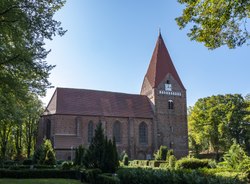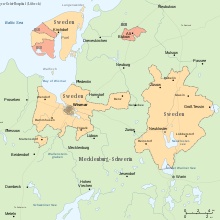Poel
Insel Poel | |
|---|---|
 Church in Kirchdorf | |
| Coordinates:54°00′N11°26′E/ 54.000°N 11.433°E | |
| Country | Germany |
| State | Mecklenburg-Vorpommern |
| District | Nordwestmecklenburg |
| Subdivisions | 15 Ortsteile |
| Government | |
| •Mayor | Gabriele Richter |
| Area | |
| • Total | 36.02 km2(13.91 sq mi) |
| Highest elevation | 26 m (85 ft) |
| Lowest elevation | 0 m (0 ft) |
| Population (2022-12-31)[1] | |
| • Total | 2,528 |
| • Density | 70/km2(180/sq mi) |
| Time zone | UTC+01:00(CET) |
| • Summer (DST) | UTC+02:00(CEST) |
| Postal codes | 23999 |
| Dialling codes | 038425 |
| Vehicle registration | NWM |
| Website | www.insel-poel.de |
Poel(German pronunciation:[ˈpøːl]) orPoel Island(German:Insel Poel), is an island in theBaltic Sea.It forms the natural northern and eastern boundaries of theBay of Wismaron the German coast. The northern coast of the island is also on the south side of the large gulf known as theBay of Mecklenburg,which Wismar Bay enters into. Insel Poel thus forms on its northern side the unofficiallatitudeof the northern boundary of the Wismar Bay.


It is close to the cities ofLübeck,WismarandSchwerinand is part of theHamburg Metropolitan Region.
Administratively it is a municipality in theNordwestmecklenburgdistrict. It consists of Kirchdorf and Oertzenhof (the main towns) and the smaller villages of Timmendorf, Wangern, Hinterwangern, Weitendorf, Weitendorf-Hof, Brandenhusen, Neuhof, Seedorf, Niendorf, Schwarzer Busch, Kaltenhof, Fährdorf, Malchow, Vorwerk and Gollwitz. It covers an area of 36.02 km2(13.91 sq mi) and has 2,873 citizens. Satellite pictures show that most of it is used as farmland.[citation needed]With its good air, clean water, fine beaches and sheltered harbours, it is also popular recreational area. At Timmendorf harbour there are a pilot's station and facilities for yachts and local fishermen. Kirchdorf has a yachting harbour and a boatyard. Wismar Bay is cited by theEncyclopædia Britannica Eleventh Edition(1910-1911) as the finest harbor on the Baltic.
The island's name derives frompole,theCommon Slavicword for "flat land" or "field".
History[edit]

Poel's first inhabitants in historic times were Slavs, belonging to the West Mecklenburgian tribe of theObotrites.The Slavic ruler and Lord of MecklenburgHeinrich Borwin Ibrought German settlers from the providences ofDithmarschenandHolsteinto the island in the early 13th century. They began building the church on Poel around 1210. The church was built in four or five periods and was completed around 1350. The tower (the oldest part of the building) is inRomanesquestyle, and with its 47 meters it is visible from almost all points on the island. The church nave was originally Romanesque in style, was enlargened however around 1300 with a long and high choir and at that time changed into theGothicstyle. The church which still remains a major sightseeing attraction on the island contains two winged Marian altars from the 15th century, atriumphal crossfrom around 1450, a rare Danish gravestone from the 13th century and the model of a Zeesenboat from 1936. Since about 1535 it is aLutheranChurch.[2]Besides the weeklyDivine Servicethere are also many concerts with classical music in the church during the summer months.
In 1614 Duke of MecklenburgAdolf Friedrich Istarted the construction of a fortress on the island in the vicinity of the church, making use of the strategically good location. In 1618 it was completed. In June 1620Gustavus AdolphusII of Sweden visited his cousin Duke Johann Albrecht II here, and in September of that same year his bride-to-be, PrincessMaria Eleonora of Brandenburg,visited the island and stayed at the castle on the way to her marriage in Stockholm. She was received by Duke Johann Albrecht II with a festive worship service in the church and will a feast that went on for several days. During theThirty Years' Warthe Duke had to give up the castle to enemy imperial troops (= Catholic coalition) in 1628. GeneralWallensteinruled over Mecklenburg for several years.
In 1631 Gustav Adolf helped the dukes of Mecklenburg regain their power, and Johann Albrecht II returned to Poel finding the castle in a desolate condition. When Mecklenburg signed a truce with EmperorFerdinand II (Holy Roman Empire)in 1635, the Swedes invaded the land and took over the castle on Poel. The emperor's troops returned in 1638, drove the Swedes away and burned several villages.

After theTreaty of Westphaliain 1648 two-thirds of Poel together withWismarand the municipality ofNeuklosterwere granted to the King of Sweden. The western third of the island remained the property of the Holy-Spirit-Hospital (Heiligen-Geist-Hospital) inLübeckwhich had already had this endowment for several centuries. The Swedes were in possession of the castle on Poel but had no interest in it, since they invested all their money and efforts in makingWismara major military centre on the Baltic Sea. The castle quickly deteriorated and by 1740 there were only ruins left.
In the 19th century the inhabitants of Poel were allowed to use the bricks to build their homes and barns so that the buildings were completely disassembled. Today one still can see the impressive earthen embankments and most of the moats which were constructed between 1614 and 1618 for defense purposes. The castle grounds were formed in a five-pointed star form, and the church with its grounds (see above) were enclosed into a similar defense compound in the shape of the tail of a star (the so-called "Hornewerck" ). In November 1802 the House ofMecklenburgunder the leadership of DukeFriedrich Franz Icame in possession of the property of the Holy-Spirit-Hospital in Lübeck. The Swedish portion of the island was leased for 99 years by the Duke in 1803. It officially remained in Swedish possession until 1903, when it completely returned to Mecklenburg.[3]
Since the 17th century Poel has been connected to the mainland with dams and bridges. Since 1927 the island has been connected to the mainland by a causeway.
In 2003 asister citytreaty was signed withHammarö Municipality,an island in lakeVänernin Sweden.
NearbyWalfischisland was also fortified.
References[edit]
- ^"Bevölkerungsstand der Kreise, Ämter und Gemeinden 2022"(XLS)(in German).Statistisches Amt Mecklenburg-Vorpommern.2023.
- ^Schlie, Friedrich: "Kunst- und Geschichts-Denkmäler des Grossherzogthums Mecklenburg-Scherwin" Vol. II, 1898, pp. 222ff.; Die Chronik der ev.-luth. Kirchgemeinde Poel 1899ff.
- ^Dr. Schröder-Lembke, Gertrud & Saegebarth, Joachim: "Insel Poel", Raum & Koch Wismar 2007, pp.82ff. (Schröder-Lembke) & pp. 197ff. (Saegebarth)







